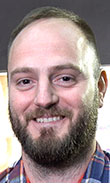Viz alumna makes movie magic, crafts special effects for Pixar
Read about
the Department of Visualization's Summer Industry Workshop with Disney Pixar Studio pros.

See interview with Jon Kiker, Pixar lighting technical director and 2008 MS-Viz grad.
Weapons fire around a dark-haired girl. She steels herself, raises her hands and smiles –– a pulsating orb of purple-blue light suddenly surrounds her, an impenetrable force field. Now protected, it’s time to save her family.
In the animated movie “Incredibles 2,” the force field, among other effects, were made by Pixar artist and Texas A&M former visualization student Sarah Beth Eisenger ’13, who has used her technical wizardry skills on “Coco,” “Finding Dory,” Inside Out,” and other acclaimed films.
Now an effects technical director at Disney Pixar Animation Studios, Eisenger earned a Master of Visualization degree from the College of Architecture in 2013 and also holds a bachelor’s degree in electrical engineering and computer science from the University of California, Berkeley.
She recently returned to her alma mater to serve as an industry expert for the [Department of Visualization Summer Industry Workshop] (http://one.arch.tamu.edu/news/2018/9/21/grad-vizzers-create-animated-short-films-disney-pixars-guidance/) , where she and a team of Pixar artists helped students as they crafted animated shorts from scratch using a real-world production pipeline.
Eisenger recently spoke about her work and trajectory from the Viz Lab to Pixar.
What does a special effects artist do?
“I work on anything that moves on screen that isn’t a character. I create fire, water, smoke, magic, anything like that. I’ve been lucky enough to do effects like Violet’s force field in Incredibles 2, which was a dream effect because it’s something that doesn’t exist in the real world and you get to make every part of it.”
How did you create it?
“I had to create a whole system for her and it to turn invisible and re-appear so the audience could see the transition. It involves taking the original geometry of her body and the sphere and scattering thousands of points across it. I assign each point a color and then, using the colors to create a sequence of images, then composite the original image into the background.”
How did your time at Texas A&M prepare you for your current career?
“I first learned about the Viz Lab as an undergraduate student in California when interning at Pixar on “Ratatouille” and a lot of my fellow interns and staff came from Texas A&M — they had great eyes for the work. Coming here for graduate school, I cultivated greater breadth of knowledge to pull from and also improved my ability to problem solve and work with people. So much of animation is about being able to collaboratively work together and that is practiced here, exactly like these workshop students are doing.”
What are your impressions of the students’ work this summer?
“I’m continuously blown away at how creative the students are and how quickly they apply notes. One of the mentors made a comment about how it would be cool for a team’s short to be more like ‘The Jetsons,’ and the next time we met they had multiple new versions. Also, when you work in a full animation studio, there are people there to update and customize the tools available – the students here are very creative in customizing the tools they have and finding workarounds for problems. I’m very impressed.”
If a student wants to work at Pixar when they graduate, what does it take to get there?
“The best thing you can do is figure out what areas of animation most interest you and the best way to do that is to try everything once. Take an ‘Intro to 3-D modeling and animation’ class where you make an entire short by yourself from start to finish to see which aspects you like and dislike. Also practice on your own at home. It’s great to have a depth of knowledge about the area you want to work in but also a breadth of knowledge about the world you live in – because so much of animation is making things feel like a fantastic form of how they are in the world. We stylize reality in a way that’s visually appealing.”
Sarah Wilson
swilson@arch.tamu.edu
Tags
Related Posts

Pixar Viz alumnus enlightens students with technical skills
Texas A&M ranked with top animation schools in nation

Viz students’ art showcased at regional art center

Viz ranked as top public program by College Magazine

Viz department work showcased at global graphics conference
Follow Us
Facebook Twitter Vimeo Youtube Flickr RSS
Recent Posts

Planning prof heads study of disaster housing aid

A message from the dean

Former student remembered as expert planner

Leading educator named new head of Architecture Dept.





_thumbnail_small.png)
